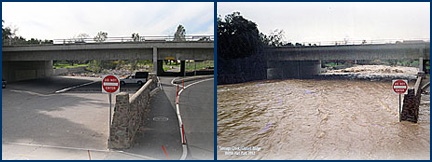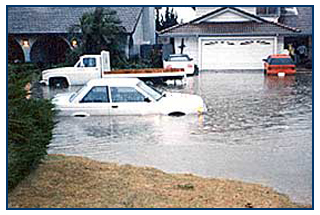Safety & Education Introduction
Brochures
History
During the 20th century, floods were the number-one natural disaster in the United States in terms of number of lives lost and property damage. They can occur at any time of the year, in any part of the country, and at any time of the day or night. Most lives are lost when people are swept away by flood currents, whereas most property damage results from inundation by sediment-laden water. Flood currents also possess tremendous destructive power, as lateral forces can demolish buildings and erosion can undermine bridge foundations and footings leading to the collapse of structures.

Santiago Creek at Glassell Bridge in Hart Park, 2004 and 1992
Flood Facts
- Floods and flash floods happen in all 50 states.
- Most communities in the United States can experience some kind of flooding after spring rains, heavy thunderstorms, or winter snow thaws. Floods can be slow or fast rising but generally develop over a period of days.
- Hurricanes, winter storms and snow melt are common (but often overlooked) causes of flooding.
- New land development can increase flood risk, especially if the construction changes natural runoff paths.
- Dam failures are potentially the worst flood events. A dam failure is usually the result of neglect, poor design, or structural damage caused by a major event such as an earthquake. When a dam fails, a gigantic quantity of water is suddenly let loose downstream, destroying anything in its path.
- Flooding has caused the deaths of more than 10,000 people in the United States since 1900 and property damage from flooding now totals over $2 billion each year.
- Flood waters can be extremely dangerous. The force of six inches of swiftly moving water can knock people off their feet. The best protection during a flood is to leave the area and go to shelter on higher ground.
- A car can easily be carried away by just two feet of floodwater. If flood waters rise around a car, it should be abandoned. Passengers should climb to higher ground.
- Most flood-related deaths are due to flash floods.
- Nearly fifty percent of all flash-flood fatalities are vehicle related.
- Flash flood waters move at very fast speeds and can roll boulders, tear out trees, destroy buildings, and obliterate bridges. Walls of water can reach heights of 10 to 20 feet and generally are accompanied by a deadly cargo of debris. The best response to any signs of flash flooding is to move immediately and quickly to higher ground.
- Just an inch of water can cause costly damage to your property.
- In a high risk area, your home has a 26% chance of being damaged by a flood during the course of a 30-year mortgage, compared to a 4% chance of fire.
- Most homeowner’s insurance policies do not cover floodwater damage. See Flood Insurance for more information.
In this section of the web site you will find facts about flooding, how to prepare for and cope with a flood event, emergency information, and weather and flood watch information.
This information was compiled from the websites of:
- U.S. Geological Survey - usgs.gov
- FEMA - fema.gov
- Floodsmart - floodsmart.gov
A flood, as defined by the National Flood Insurance Program is: "A general and temporary condition of partial or complete inundation of two or more acres of normally dry land area or of two or more properties (at least one of which is your property) from:
- Overflow of inland or tidal waters, or
- Unusual and rapid accumulation or runoff of surface waters from any source, or
- A mudflow, or
- The collapse or subsidence of land along the shore of a lake or similar body of water as a result of erosion or undermining caused by waves or currents of water exceeding anticipated cyclical levels that result in a flood.

Los Alamitos - Rochelle Street January 4, 1995. Photo by Marvin Jempsa.
The collapse or subsidence of land along the shore of a lake or similar body of water as a result of erosion or undermining caused by waves or currents of water exceeding anticipated cyclical levels that result in a flood."
Floods can be slow or fast rising but generally develop over a period of days. Mitigation includes any activities that prevent an emergency, reduce the chance of an emergency happening, or lessen the damaging effects of unavoidable emergencies. Investing in mitigation steps now, such as, engaging in floodplain management activities, constructing barriers, such as levees, and purchasing flood insurance will help reduce the amount of structural damage to your home and financial loss from building and crop damage should a flood or flash flood occur.
What is a Flash Flood?
Flash floods usually result from intense storms dropping large amounts of rain within a brief period. Flash floods occur with little or no warning and can reach full peak in only a few minutes.
Flash flood water move at very fast speeds and can roll boulders, tear out trees, destroy buildings, and obliterate bridges. Walls of water can reach heights of 10 to 20 feet and generally are accompanied by a deadly cargo of debris. The best response to any sign of flash flooding is to move immediately and quickly to higher ground.
Common Misconceptions About Flooding
- Since we recently had a 100-year flood, I will be safe from flooding for another 100 years.
- If my house or property was not flooded in the last flood, then it is not in a floodplain and I don't need to be concerned about flooding.
- If I locate my home outside the floodplain I will never have any flood damages.
- If it is not raining in my neighborhood, then the wash next to my house will not flow.
- Placing branches along the embankment of a wash is an effective method of flood protection.
- If a roadway dip section looks like it has only 6-8 inches of water running over it, then it is safe for me to cross.
- I can make any drainage improvement I need to on my own private land.
